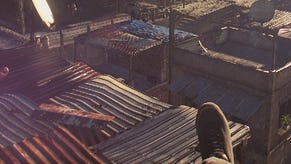Brink
Gun running.
In the run-up to the release of Splash Damage's team-based shooter Brink, there has been an odd reluctance to state plainly what, at heart, the game is about.
Perhaps it's because Brink's heritage lies in the mod scene, where its fundamental ideas were beaten into shape by amateurs. Or maybe it's because Splash Damage's Enemy Territory: Quake Wars, with which Brink shares its basic approach, sold only modestly. Or has it been fear on the part of publisher Bethesda that the team-based shooter at its core isn't quite enough to raise blockbuster expectations on its own?
Instead, there has been much talk of parkour, with videos of free-running experts launching themselves over virtual crates, in the hope of lending an air of street chic to the hype. There have been tourist guides to the setting: the futuristic floating city The Ark, a final refuge for mankind whose offices and corridors furnish the game's maps.
There's been the focus on the divisive and unique character designs: Gears of War marines redrawn by a 19th-century Punch cartoonist, with an exaggerated gauntness and muscle. Most recently, there have been the in-depth tutorial videos discussing high-level tactics and the intricacies of Brink's strategic game.
But what has somehow been missed in the marketing bluster is that Brink is a game of cops vs. robbers.
Yes, the S.M.A.R.T. system used to move your character through the environment is fluid and fascinating, allowing you to climb up and over obstacles in search of the quickest route to your objective. Yes, the Ark provides some interesting locations. There's no denying that Splash Damage has refined the genre by way of a host of fine-level design details here.
But it's important to be fully aware that Brink is Reds vs. Blues, Cowboys vs. Indians, Resistance vs. Security. There are eight men on each side, whether you're playing online or alone – and it's not quite as complicated as it's been made out to be.

The game does its best to convince you otherwise. Lured by the promise of a bonus 1000 experience points, you start by watching a long, overly technical set of videos which seek to introduce Brink's class system, free-running model and objective-based play.
The developer seems concerned that the learning curve is going to be too steep for most, or that all of its ideas need to be communicated in the first five minutes. But a non-interactive film makes a poor opening, and has the opposite of the intended effect, introducing mild panic and a sense of confusion from the off.
What should have been Brink's inaugural tutorial is tucked away inside the first Challenge Room, a smart, straightforward micro-mission that introduces you to the four character classes, their abilities and the kind of objectives you'll encounter as you try to defeat the opposing team in the 12 missions that comprise the main campaign.
Brink doesn't distinguish between single-player and multiplayer, or co-op and competitive play; it's all part of this campaign. You join seven others (players, bots or a mixture, depending on your preference) working to complete a set of linear objectives (breaching doors, stealing data and escorting valuable cargo) while the opposing team attempts to thwart your plans. You can choose whether your opponents are human or AI, too.
The four classes are the Soldier, able to rig explosives to blow up doors; the Engineer, who can deploy turrets, defuse explosives and fix vehicles; the Medic, who can revive fallen team-mates and increase the maximum health of those around him; and the Operative, able to disguise himself as an enemy and hack terminals.
During the course of a mission each class type may be required to complete a primary objective. An effective team will enjoy a balance of classes to benefit from each unit's buffs, but weapon choice and offensive shooting capability is consistent across them all.
It's a smart decision, since it means that you can slip seamlessly between Medic, Solider, Engineer and Operative without any change to your preferred style of gunplay. Command Posts enable you to switch class on the ground, especially useful when playing alongside AI - you'll want to take the primary objectives into your own, more capable hands. The AI's performance is mixed; you won't want to trust it with these, but it does provide decent enough back-up to finish the campaign solely alongside bots if you want to.









